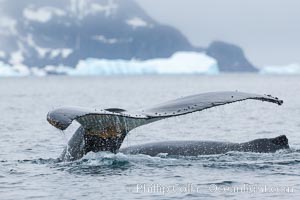
Southern humpback whale in Antarctica, lifting its fluke (tail) before diving in Cierva Cove, Antarctica.
Species: Humpback whale, Megaptera novaeangliae
Location: Cierva Cove, Antarctic Peninsula, Antarctica
Image ID: 25518
Species: Humpback whale, Megaptera novaeangliae
Location: Cierva Cove, Antarctic Peninsula, Antarctica
Image ID: 25518
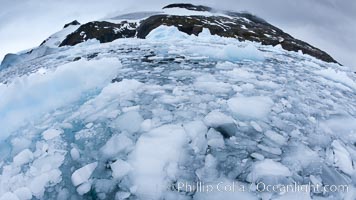
Brash ice and pack ice in Antarctica. Brash ices fills the ocean waters of Cierva Cove on the Antarctic Peninsula. The ice is a mix of sea ice that has floated near shore on the tide and chunks of ice that have fallen into the water from nearby land-bound glaciers.
Location: Cierva Cove, Antarctic Peninsula, Antarctica
Image ID: 25531
Location: Cierva Cove, Antarctic Peninsula, Antarctica
Image ID: 25531
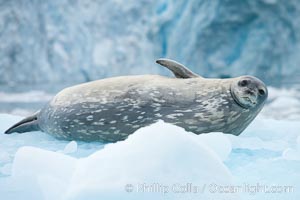
Weddell seal in Antarctica. The Weddell seal reaches sizes of 3m and 600 kg, and feeds on a variety of fish, krill, squid, cephalopods, crustaceans and penguins.
Species: Weddell seal, Leptonychotes weddellii
Location: Cierva Cove, Antarctic Peninsula, Antarctica
Image ID: 25501
Species: Weddell seal, Leptonychotes weddellii
Location: Cierva Cove, Antarctic Peninsula, Antarctica
Image ID: 25501
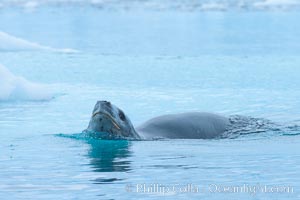
A leopard seal in Antarctica. The leopard seal is a large predatory seal, up to 1300 lb and 11 ft in length, feeding on krill, squid, fish, various penguin species and other seabirds and occasionally, other pinnipeds.
Species: Leopard seal, Hydrurga leptonyx
Location: Cierva Cove, Antarctic Peninsula, Antarctica
Image ID: 25526
Species: Leopard seal, Hydrurga leptonyx
Location: Cierva Cove, Antarctic Peninsula, Antarctica
Image ID: 25526
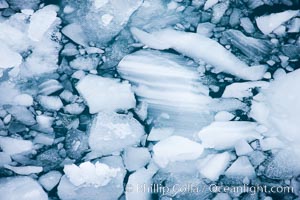
Brash ice floats on cold, dark Antarctic waters.
Location: Cierva Cove, Antarctic Peninsula, Antarctica
Image ID: 25532
Location: Cierva Cove, Antarctic Peninsula, Antarctica
Image ID: 25532
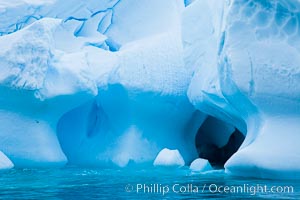
Antarctic icebergs, sculpted by ocean tides into fantastic shapes.
Location: Cierva Cove, Antarctic Peninsula, Antarctica
Image ID: 25502
Location: Cierva Cove, Antarctic Peninsula, Antarctica
Image ID: 25502
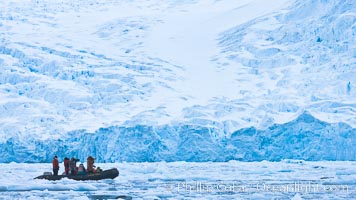
Zodiac cruising in Antarctica. Tourists enjoy the pack ice and towering glaciers of Cierva Cove on the Antarctic Peninsula.
Location: Cierva Cove, Antarctic Peninsula, Antarctica
Image ID: 25529
Location: Cierva Cove, Antarctic Peninsula, Antarctica
Image ID: 25529
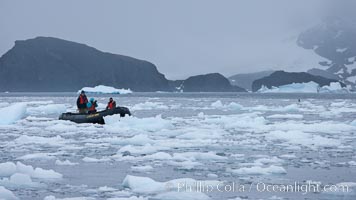
Zodiac cruising in Antarctica. Motoring in an inflatable zodiac through pack ice along the Antarctic Peninsula.
Location: Cierva Cove, Antarctic Peninsula, Antarctica
Image ID: 25563
Location: Cierva Cove, Antarctic Peninsula, Antarctica
Image ID: 25563
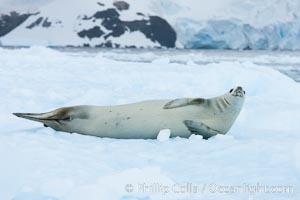
A crabeater seal, hauled out on pack ice to rest. Crabeater seals reach 2m and 200kg in size, with females being slightly larger than males. Crabeaters are the most abundant species of seal in the world, with as many as 75 million individuals. Despite its name, 80% the crabeater seal's diet consists of Antarctic krill. They have specially adapted teeth to strain the small krill from the water.
Species: Crabeater seal, Lobodon carcinophagus
Location: Cierva Cove, Antarctic Peninsula, Antarctica
Image ID: 25576
Species: Crabeater seal, Lobodon carcinophagus
Location: Cierva Cove, Antarctic Peninsula, Antarctica
Image ID: 25576
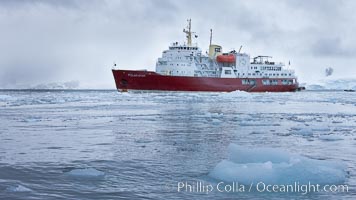
Icebreaker M/V Polar Star, anchored amid pack ice in Cierva Cove.
Location: Cierva Cove, Antarctic Peninsula, Antarctica
Image ID: 25598
Location: Cierva Cove, Antarctic Peninsula, Antarctica
Image ID: 25598
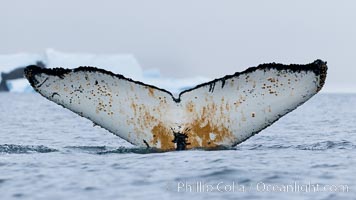
Southern humpback whale in Antarctica, with significant diatomaceous growth (brown) on the underside of its fluke, lifting its fluke before diving in Cierva Cove, Antarctica.
Species: Humpback whale, Megaptera novaeangliae
Location: Cierva Cove, Antarctic Peninsula, Antarctica
Image ID: 25497
Species: Humpback whale, Megaptera novaeangliae
Location: Cierva Cove, Antarctic Peninsula, Antarctica
Image ID: 25497
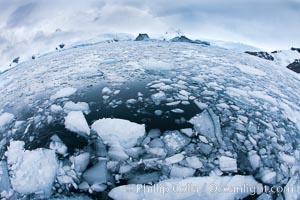
Brash ice and pack ice in Antarctica. Brash ices fills the ocean waters of Cierva Cove on the Antarctic Peninsula. The ice is a mix of sea ice that has floated near shore on the tide and chunks of ice that have fallen into the water from nearby land-bound glaciers.
Location: Cierva Cove, Antarctic Peninsula, Antarctica
Image ID: 25503
Location: Cierva Cove, Antarctic Peninsula, Antarctica
Image ID: 25503
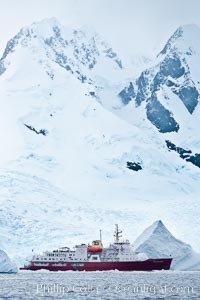
Icebreaker M/V Polar Star, at anchor, Cierva Cove.
Location: Cierva Cove, Antarctic Peninsula, Antarctica
Image ID: 25517
Location: Cierva Cove, Antarctic Peninsula, Antarctica
Image ID: 25517
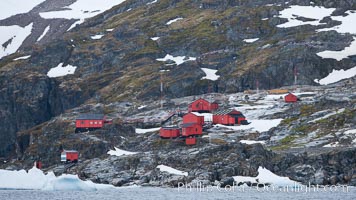
Primavera Base, (Argentina) on the slopes above Cierva Cove, Antarctica.
Location: Cierva Cove, Antarctic Peninsula, Antarctica
Image ID: 25556
Location: Cierva Cove, Antarctic Peninsula, Antarctica
Image ID: 25556
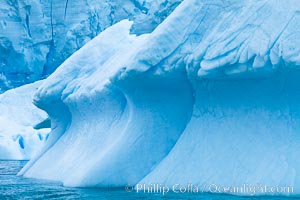
Antarctic icebergs, sculpted by ocean tides into fantastic shapes.
Location: Cierva Cove, Antarctic Peninsula, Antarctica
Image ID: 25500
Location: Cierva Cove, Antarctic Peninsula, Antarctica
Image ID: 25500
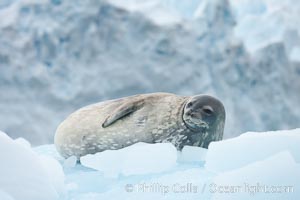
Weddell seal in Antarctica. The Weddell seal reaches sizes of 3m and 600 kg, and feeds on a variety of fish, krill, squid, cephalopods, crustaceans and penguins.
Species: Weddell seal, Leptonychotes weddellii
Location: Cierva Cove, Antarctic Peninsula, Antarctica
Image ID: 25520
Species: Weddell seal, Leptonychotes weddellii
Location: Cierva Cove, Antarctic Peninsula, Antarctica
Image ID: 25520
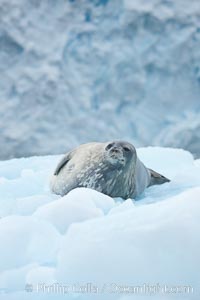
Weddell seal in Antarctica. The Weddell seal reaches sizes of 3m and 600 kg, and feeds on a variety of fish, krill, squid, cephalopods, crustaceans and penguins.
Species: Weddell seal, Leptonychotes weddellii
Location: Cierva Cove, Antarctic Peninsula, Antarctica
Image ID: 25521
Species: Weddell seal, Leptonychotes weddellii
Location: Cierva Cove, Antarctic Peninsula, Antarctica
Image ID: 25521
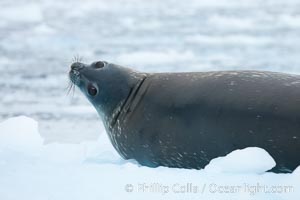
Weddell seal in Antarctica. The Weddell seal reaches sizes of 3m and 600 kg, and feeds on a variety of fish, krill, squid, cephalopods, crustaceans and penguins.
Species: Weddell seal, Leptonychotes weddellii
Location: Cierva Cove, Antarctic Peninsula, Antarctica
Image ID: 25522
Species: Weddell seal, Leptonychotes weddellii
Location: Cierva Cove, Antarctic Peninsula, Antarctica
Image ID: 25522
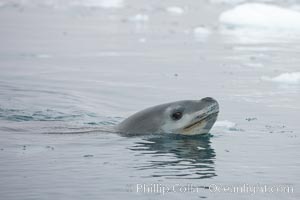
A leopard seal in Antarctica. The leopard seal is a large predatory seal, up to 1300 lb and 11 ft in length, feeding on krill, squid, fish, various penguin species and other seabirds and occasionally, other pinnipeds.
Species: Leopard seal, Hydrurga leptonyx
Location: Cierva Cove, Antarctic Peninsula, Antarctica
Image ID: 25523
Species: Leopard seal, Hydrurga leptonyx
Location: Cierva Cove, Antarctic Peninsula, Antarctica
Image ID: 25523
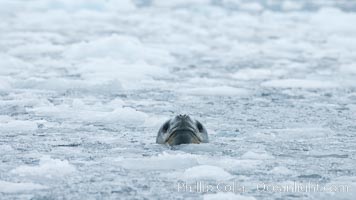
A leopard seal in Antarctica. The leopard seal is a large predatory seal, up to 1300 lb and 11 ft in length, feeding on krill, squid, fish, various penguin species and other seabirds and occasionally, other pinnipeds.
Species: Leopard seal, Hydrurga leptonyx
Location: Cierva Cove, Antarctic Peninsula, Antarctica
Image ID: 25524
Species: Leopard seal, Hydrurga leptonyx
Location: Cierva Cove, Antarctic Peninsula, Antarctica
Image ID: 25524
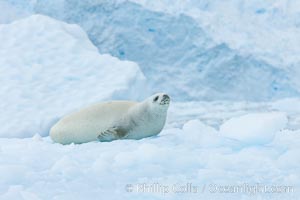
A crabeater seal, hauled out on pack ice to rest. Crabeater seals reach 2m and 200kg in size, with females being slightly larger than males. Crabeaters are the most abundant species of seal in the world, with as many as 75 million individuals. Despite its name, 80% the crabeater seal's diet consists of Antarctic krill. They have specially adapted teeth to strain the small krill from the water.
Species: Crabeater seal, Lobodon carcinophagus
Location: Cierva Cove, Antarctic Peninsula, Antarctica
Image ID: 25525
Species: Crabeater seal, Lobodon carcinophagus
Location: Cierva Cove, Antarctic Peninsula, Antarctica
Image ID: 25525
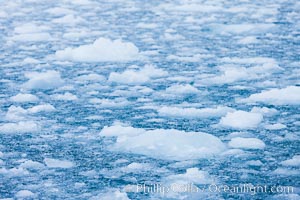
Brash ice and pack ice in Antarctica. Brash ices fills the ocean waters of Cierva Cove on the Antarctic Peninsula. The ice is a mix of sea ice that has floated near shore on the tide and chunks of ice that have fallen into the water from nearby land-bound glaciers.
Location: Cierva Cove, Antarctic Peninsula, Antarctica
Image ID: 25527
Location: Cierva Cove, Antarctic Peninsula, Antarctica
Image ID: 25527
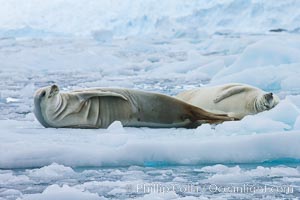
Crabeater seal resting on pack ice. Crabeater seals reach 2m and 200kg in size, with females being slightly larger than males. Crabeaters are the most abundant species of seal in the world, with as many as 75 million individuals. Despite its name, 80% the crabeater seal's diet consists of Antarctic krill. They have specially adapted teeth to strain the small krill from the water.
Species: Crabeater seal, Lobodon carcinophagus
Location: Cierva Cove, Antarctic Peninsula, Antarctica
Image ID: 25530
Species: Crabeater seal, Lobodon carcinophagus
Location: Cierva Cove, Antarctic Peninsula, Antarctica
Image ID: 25530
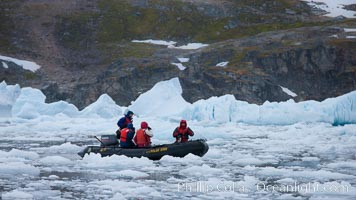
Zodiac cruising in Antarctica. Motoring in an inflatable zodiac through pack ice along the Antarctic Peninsula.
Location: Cierva Cove, Antarctic Peninsula, Antarctica
Image ID: 25564
Location: Cierva Cove, Antarctic Peninsula, Antarctica
Image ID: 25564
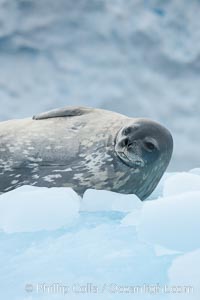
Weddell seal in Antarctica. The Weddell seal reaches sizes of 3m and 600 kg, and feeds on a variety of fish, krill, squid, cephalopods, crustaceans and penguins.
Species: Weddell seal, Leptonychotes weddellii
Location: Cierva Cove, Antarctic Peninsula, Antarctica
Image ID: 25566
Species: Weddell seal, Leptonychotes weddellii
Location: Cierva Cove, Antarctic Peninsula, Antarctica
Image ID: 25566
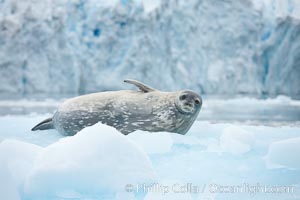
Weddell seal in Antarctica. The Weddell seal reaches sizes of 3m and 600 kg, and feeds on a variety of fish, krill, squid, cephalopods, crustaceans and penguins.
Species: Weddell seal, Leptonychotes weddellii
Location: Cierva Cove, Antarctic Peninsula, Antarctica
Image ID: 25567
Species: Weddell seal, Leptonychotes weddellii
Location: Cierva Cove, Antarctic Peninsula, Antarctica
Image ID: 25567
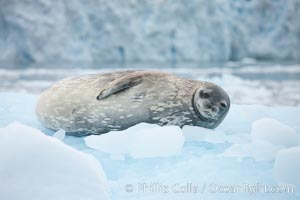
Weddell seal in Antarctica. The Weddell seal reaches sizes of 3m and 600 kg, and feeds on a variety of fish, krill, squid, cephalopods, crustaceans and penguins.
Species: Weddell seal, Leptonychotes weddellii
Location: Cierva Cove, Antarctic Peninsula, Antarctica
Image ID: 25568
Species: Weddell seal, Leptonychotes weddellii
Location: Cierva Cove, Antarctic Peninsula, Antarctica
Image ID: 25568
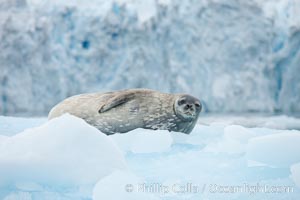
Weddell seal in Antarctica. The Weddell seal reaches sizes of 3m and 600 kg, and feeds on a variety of fish, krill, squid, cephalopods, crustaceans and penguins.
Species: Weddell seal, Leptonychotes weddellii
Location: Cierva Cove, Antarctic Peninsula, Antarctica
Image ID: 25569
Species: Weddell seal, Leptonychotes weddellii
Location: Cierva Cove, Antarctic Peninsula, Antarctica
Image ID: 25569
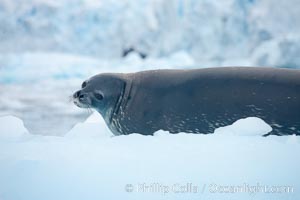
Weddell seal in Antarctica. The Weddell seal reaches sizes of 3m and 600 kg, and feeds on a variety of fish, krill, squid, cephalopods, crustaceans and penguins.
Species: Weddell seal, Leptonychotes weddellii
Location: Cierva Cove, Antarctic Peninsula, Antarctica
Image ID: 25570
Species: Weddell seal, Leptonychotes weddellii
Location: Cierva Cove, Antarctic Peninsula, Antarctica
Image ID: 25570
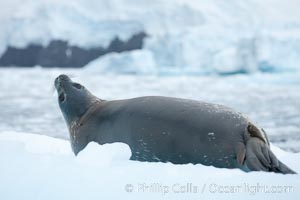
Weddell seal in Antarctica. The Weddell seal reaches sizes of 3m and 600 kg, and feeds on a variety of fish, krill, squid, cephalopods, crustaceans and penguins.
Species: Weddell seal, Leptonychotes weddellii
Location: Cierva Cove, Antarctic Peninsula, Antarctica
Image ID: 25571
Species: Weddell seal, Leptonychotes weddellii
Location: Cierva Cove, Antarctic Peninsula, Antarctica
Image ID: 25571